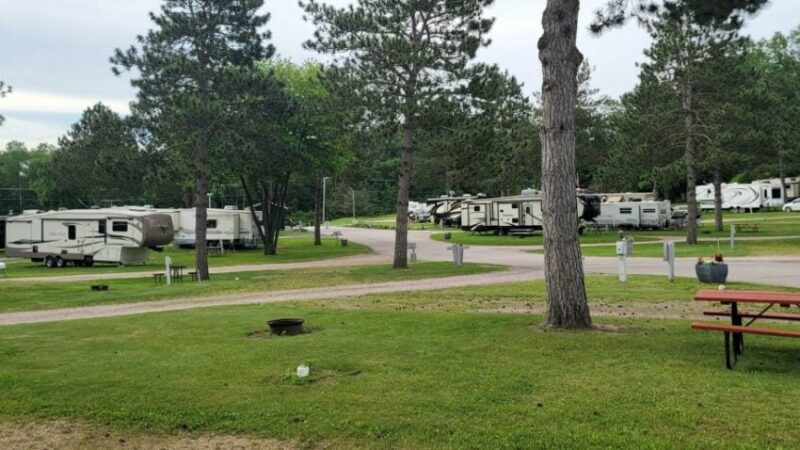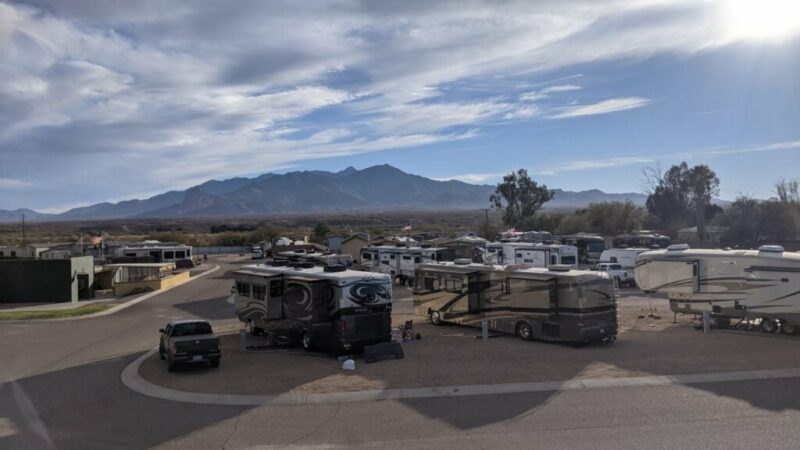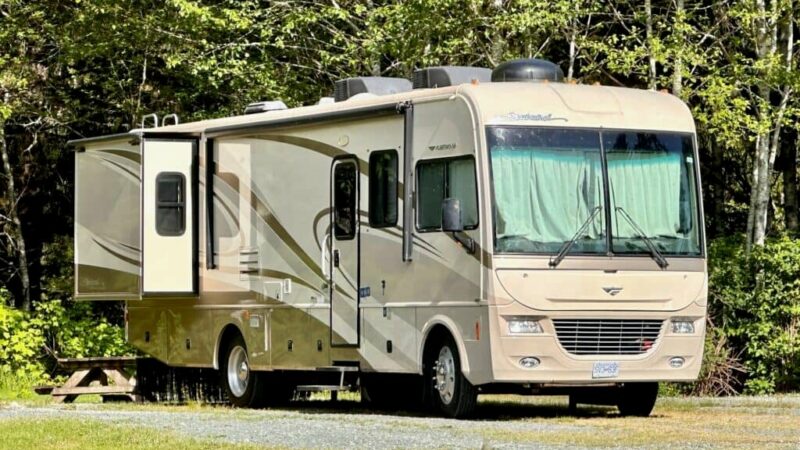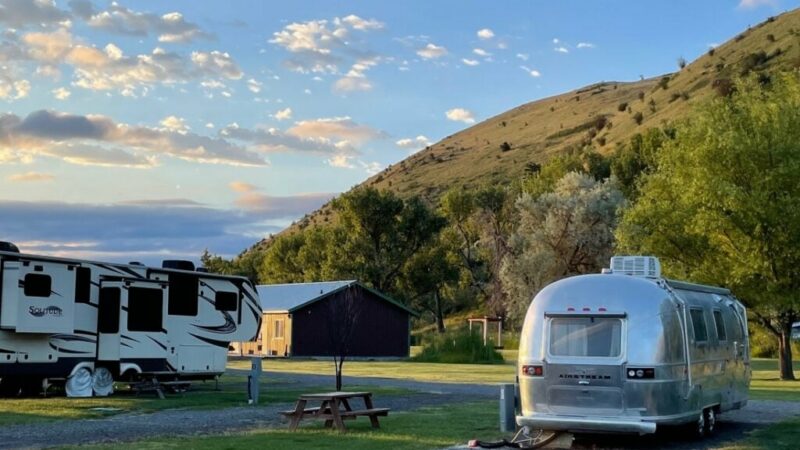Drive Safely In Dense Fog: 15 Tips RVers Need To Know
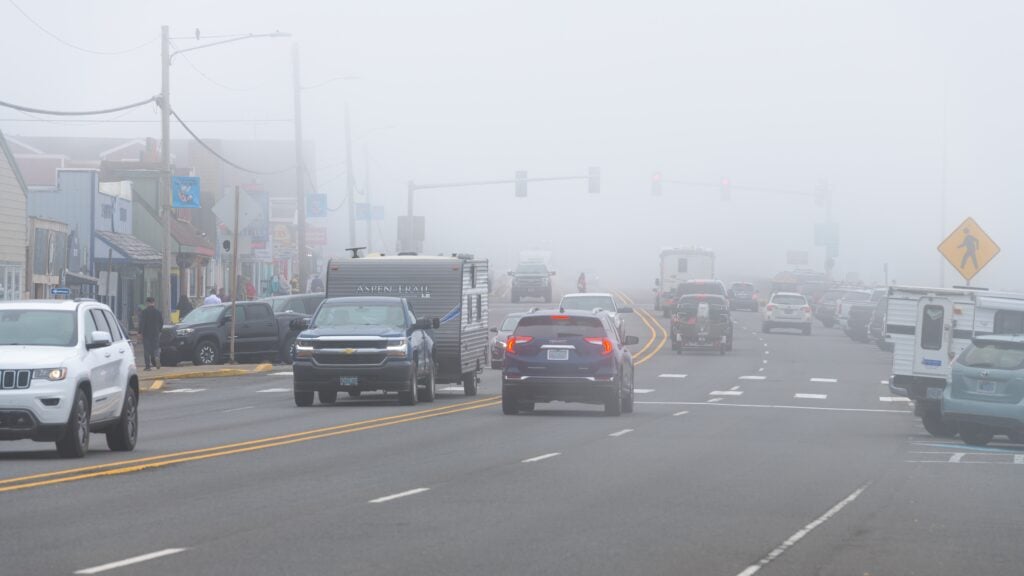
Driving In Dense Fog: 15 Safety Tips For RVers
When you travel in an RV, you need to be prepared to encounter all kinds of road conditions. Whether you take short weekend trips or long cross-country adventures, you can run into bad weather at any time. Dense fog is one of the most dangerous conditions to drive in, and every RVer needs to know how to stay safe in this situation.
Fog often occurs in patches, so you might encounter a misty stretch of road without warning. Don’t panic if you find yourself surrounded by a gray haze! It can be unnerving to drive an RV in these conditions, but as long as you take the proper precautions, you should be able to reach the other end without an issue.
There are lots of ways for you to stay safe while you navigate dense fog. Sometimes you’ll only need to drive for a few minutes until you’re out of the haze. But in other cases, you might be stuck for a few hours. Regardless of how long or short your drive is, there are plenty of things you can do to improve your visibility and avoid accidents.
1. Turn on your headlights
Before you do anything else, be sure to turn on your headlights when you enter a patch of dense fog. The lights can help you see a bit further ahead, plus they will signal your position to other drivers. Both those in front of you and those behind you will want to know where you are.
2. Don’t use your high beams
Speaking of headlights, you should always try to use your low beams while you’re driving through fog. High beams or bright lights can actually make it harder to see in front of you! These lights tend to reflect off of the fog, creating a harsh glare that’s difficult to see through.
Low beams are the better option for this situation. In addition, you should turn on your fog lights if you have them. These are low-mounted lights that are designed to illuminate the road in front of you. Not every vehicle has these, but they definitely come in handy when there’s poor visibility.
3. Turn off your cruise control
Once you have your lights on, it’s time to switch over to manual driving. Cruise control is a fantastic function, but it’s better for you to have direct control of your vehicle when it’s foggy. You need to be able to react quickly, so it’s a good idea to keep your foot hovering over the brake.
4. Slow down and increase your following distance
It’s never smart to speed in an RV, but it’s especially dangerous when you’re driving through dense fog. It may be difficult to see obstacles and vehicles in your path. You’ll need to give yourself as much reaction time as possible, so it’s a good idea to slow down.
Give the vehicle in front of you a decent following distance as well. They might suddenly slam on their brakes if something emerges from the fog, so you need to give yourself plenty of time to stop.
The people behind you might become impatient and try to tailgate you, so you’ll speed up. But it’s important to stick to the pace that makes you comfortable. It’s much better to be safe rather than speedy.
5. Reduce distractions
Driving can be stressful at the best of times, but it’s even worse when you need to deal with a thick blanket of fog. You’ll want to devote your full attention to the road so you can avoid an accident. Turn off your music, ask your fellow passengers to quiet down, and stay alert.
6. Roll your window down to hear better
Turning off your music, podcasts, or radio is a good start to improving your awareness. But your RV can still produce plenty of noise on its own. This makes it difficult to hear outside noises. Because your visibility is limited, you may want to roll down your window a bit so you can better hear the sound of traffic. This way, you’ll have a heads up if there are any sirens, large trucks, or people who are yelling outside.
7. Use windshield wipers and a warm defroster setting
Fog makes everything more difficult to see. But it’s also a cloud of moisture, which can create a temperature/humidity difference between your RV interior and your surroundings. In these circumstances, your windows might start to fog up.
Your defroster can help with this. Turn it on and use the warm setting to evaporate condensation as it forms. Then you can use your wipers to clear away moisture from the outside of your windshield.
8. Use solid right lane markers rather than dashed middle lanes
Lane drift is one of the biggest risks while you’re driving in the fog. It’s hard to see the road and other markers, so you might drift into another lane without realizing it. To combat this, you should stay in the right lane and check the solid line marker on the right side.
If you’re going to drift a bit to one side or another, it’s better to hit the rumble strips instead of veering into oncoming traffic. Use the unbroken white lines as a guide.
9. Rely on speedometer, not visual cues
It’s also quite easy to speed by accident during conditions like this. When you can’t see your surroundings, you can’t visually tell how fast you’re going. Cruise control can limit the tendency to speed, but you probably have it turned off as you navigate the dense fog.
That’s why you need to pay extra-close attention to your speedometer. Stay at or below the recommended speed limit and regularly check yourself.
10. Don’t pass unless absolutely necessary
Passing can be extremely dangerous on a foggy road. The cars around you won’t be able to quickly react to unexpected changes. Plus, it’s easy to overshoot the lane and accidentally go too far to one side.
Never attempt to pass if there’s oncoming traffic in the adjacent lane. You won’t be able to see far enough ahead to clear the distance. Highways with multiple lanes can be safer to navigate, but it’s still a risk. Unless it’s absolutely necessary, you should always try to stay in the far right lane.
11. Turn on hazards during dangerous conditions
If you’re particularly nervous about driving through dense fog, you may want to turn on your blinking hazard lights. These will make you more visible to nearby vehicles, and they will clearly communicate that you will be traveling slower than usual.
You can use hazards as a personal preference, but you may also want to turn them on if there’s debris in the road, wild animals trying to cross, or stalled vehicles on the side.
12. Look out for freezing fog and black ice
By itself, fog is already dangerous enough. But it’s even worse if the temperatures drop and ice accumulates from the droplets. You’ll need to crank the defroster into overdrive to melt ice before it settles.
These freezing conditions can also create black ice on the road. This is extremely slippery and hard to drive on. It’s even worse because you can’t always tell that it’s there! If icy conditions occur, slow down even more so you can prevent any drifting or sliding.
13. Pull over if you feel uncomfortable
If you don’t feel safe driving in the fog anymore, you may want to pull over and park. If you’re close to an exit or a rest area, that’s the ideal place to go. But sometimes you may be forced to pull onto the shoulder of the road instead.
In this case, flash your hazard lights and pull off the road as far as you can. Once you’re safely parked, turn off all your lights and wait for the fog to clear. You should turn off your lights because you don’t want people to follow you off the road. Some people just follow the lights in front of them and you could accidentally lead people off track if they see your lights.
14. Avoid driving in fog whenever possible
Finally, you should try to avoid foggy conditions as much as possible. As you can see, it’s a scary and dangerous situation to find yourself in. RVers are even more vulnerable because they need additional time to brake.
Use weather apps to check the weather on the roads. If the conditions are particularly wet or foggy, you may want to take a different route or postpone your trip for a day or two.
15. Plan an RV-safe route
RV LIFE Trip Wizard helps RV travelers plan safe routes, especially in tricky conditions like dense fog. It points out key stops like campgrounds, rest areas, and dump stations, as well as other points of interest. For on-the-go directions, pair it with the RV LIFE App to ensure a smooth and RV-friendly journey.
Related articles:
- Dust Storm Safety: What To Do If You’re Camping Or Driving
- 5 Night Driving Safety Tips You Need To Know
- Don’t Let Wind & Rain Destroy Your RV Awning
The post Drive Safely In Dense Fog: 15 Tips RVers Need To Know appeared first on RV LIFE.




